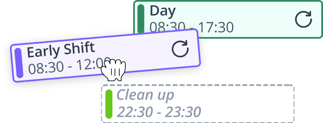In this detailed guide we take a closer look at the concept of employee onboarding, while also providing you with strategies for creating the perfect onboarding journey for new hires.
The definition of employee onboarding
Let's kick things off by asking: What is employee onboarding? In a nutshell, it's the process through which new hires learn the necessary knowledge, skills, and behaviors to become effective contributors to an organization. The process might vary across different organizations, but the main goal remains the same: setting up employees for success.
The importance of effective employee onboarding
Boosts Employee Productivity
An effective onboarding process equips new hires with the resources they need to perform at their best. It shortens the learning curve, allowing them to contribute to your organization's goals sooner. According to research by Glassdoor, a well-structured onboarding program can increase productivity by over 70%.
Enhances Employee Retention
Did you know that a staggering 20% of employee turnover happens in the first 45 days of employment? A structured onboarding process can combat this trend, making new hires feel valued and integrated into the team.
Fosters a Positive Company Culture
Employee onboarding is the perfect opportunity to instill the corporate culture, mission, and values in new hires. It allows employers to establish a strong employer brand and cultivate a supportive work environment that nurtures growth and collaboration.
Crafting the perfect employee onboarding strategy
An effective onboarding strategy isn’t a one-size-fits-all solution. It should be personalized to meet the specific needs of your organization and employees. Here are some steps to consider:
Pre-boarding
Why wait until the first day? Kick off the onboarding process as soon as the job offer is accepted. It's an ideal time to communicate expectations, clarify any uncertainties, and build enthusiasm for the role.
First Day Orientation
Make a great first impression! Orientation should be warm, welcoming, and informative. Ensure all necessary paperwork is completed, and introduce new hires to their team and workspace.
Training and Development
This step is crucial for employee onboarding. Conduct comprehensive training sessions to ensure new hires understand their roles and responsibilities. Provide tools, resources, and employee feedback to support their growth.
Mentoring and Support
Assign a mentor to new hires to guide them during their initial months. This promotes a culture of learning, enhances knowledge transfer, and aids in conflict resolution.
Ongoing Engagement
Onboarding doesn't end after the first week or month—it's a continuous process. Regular check-ins and feedback sessions can keep new hires engaged and aware of their progress.
Tools and technologies for employee onboarding
In today's digital age, a number of tools and technologies are available to streamline the onboarding process. They not only save time but also ensure consistency and effectiveness. Some popular options include:
HR Management Systems (HRMS)
Systems like HoorayHR and Personio can automate administrative tasks, freeing up time to focus on creating a more personalized onboarding experience.
Useful Read: Employee Management Software for small business - A Guide
Learning Management Systems (LMS)
Platforms like Coursera and Udemy offer a vast array of online courses that can be integrated into your training program.
Collaboration Tools
Tools such as Slack and Microsoft Teams can facilitate communication and collaboration, making it easier for new hires to connect with their colleagues.
Employee onboarding best practices
 While the specifics of an onboarding program may vary, there are a few best practices that every organization can apply:
While the specifics of an onboarding program may vary, there are a few best practices that every organization can apply:
Create a Clear Onboarding Plan
Having a structured and transparent plan can eliminate uncertainties and make the onboarding process more effective.
Cultivate a Welcoming Environment
A warm welcome can set the tone for an employee's journey. Make new hires feel valued and included right from the start.
Provide Comprehensive Training
Ensure new hires understand their roles and responsibilities. Equip them with the knowledge and tools they need to succeed.
Assign a Mentor or Buddy
Having a go-to person can ease the transition for new hires. A mentor can provide guidance, support, and feedback, fostering a sense of belonging.
Solicit Feedback and Continuously Improve
Onboarding should be an evolving process. Regular feedback from new hires can help you identify areas for improvement and fine-tune your approach.


The role of SaaS in effective employee onboarding
In our technologically driven era, Software as a Service (SaaS) solutions are revolutionizing various aspects of business operations, and employee onboarding is no exception.
Take Shiftbase, for instance—a workforce management SaaS designed to simplify and streamline employee scheduling, time tracking, and absence management. It's a one-stop-shop for all your onboarding needs, helping new hires transition smoothly into their roles.
With Shiftbase, you can automate scheduling tasks, accurately track work hours, and efficiently manage leaves and absences. All of this contributes to a seamless and efficient onboarding experience, setting your new hires up for success from day one.
Isn't it time you leveraged the power of technology to elevate your onboarding process? Why not take Shiftbase for a spin and see the difference it can make? You can try it for free for 14 days. No commitments, no hidden charges, just pure value.
Ready to revolutionize your onboarding process? Click here to start your free trial today. Transform the way you onboard, with Shiftbase.


